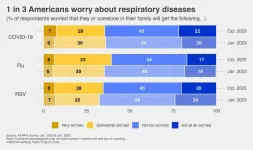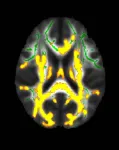Redefining the quest for artificial intelligence: What should replace the Turing test?
2023-11-20
(Press-News.org)
In a paper published Nov. 10 in Intelligent Computing, Philip Nicholas Johnson-Laird of Princeton University and Marco Ragni of Chemnitz University of Technology propose a novel alternative to the Turing test, a milestone test developed by computing pioneer Alan Turing. The paper suggests that it is time to shift the focus from whether a machine can mimic human responses to a more fundamental question: "Does a program reason in the way that humans reason?"
The Turing test, which has long been a cornerstone of AI evaluation, involves a human evaluator attempting to distinguish between human and machine responses to a series of questions. If the evaluator cannot consistently differentiate between the two, the machine is considered to have "passed" the test. While it has been a valuable benchmark in the history of AI, it has certain limitations:
Mimicry vs. Understanding: Passing the Turing test often involves mimicking human responses, making it more a test of mimicry and language generation than genuine human-like reasoning. Many AI systems excel at mimicking human conversations but lack deep reasoning capabilities.
Lack of Self-Awareness: The Turing test does not require AI to be self-aware or have an understanding of its own reasoning. It focuses solely on external interactions and responses, neglecting the introspective aspect of human cognition.
Failure to Address Thinking: Alan Turing himself recognized that the test might not truly address the question of whether machines can think. The test is more about imitation than cognition.
Johnson-Laird and Ragni outline a new evaluation framework to determine whether AI truly reasons like a human. This framework comprises three critical steps:
1. Testing in Psychological Experiments:
The researchers propose subjecting AI programs to a battery of psychological experiments designed to differentiate between human-like reasoning and standard logical processes. These experiments explore various facets of reasoning, including how humans infer possibilities from compound assertions and how they condense consistent possibilities into one, among other nuances that deviate from standard logical frameworks.
2. Self-Reflection:
This step aims to gauge the program's understanding of its own way of reasoning, a critical facet of human cognition. The program must be able to introspect on its reasoning processes and provide explanations for its decisions. By posing questions that require awareness of reasoning methods, the researchers seek to determine if the AI exhibits human-like introspection.
3. Examination of Source Code:
In the final step, the researchers delve deep into the program's source code. The key here is to identify the presence of components known to simulate human performance. These components include systems for rapid inferences, thoughtful reasoning, and the ability to interpret terms based on context and general knowledge. If the program's source code reflects these principles, the program is considered to reason in a human-like manner.
This innovative approach, replacing the Turing test with an examination of an AI program's reasoning abilities, marks a paradigm shift in the evaluation of artificial intelligence. By treating AI as a participant in cognitive experiments and even submitting its code to analysis akin to a brain-imaging study, the authors seek to bring us closer to understanding whether AI systems genuinely reason in a human-like fashion.
As the world continues its pursuit of advanced artificial intelligence, this alternative approach promises to redefine the standards for AI evaluation and move us closer to the goal of understanding how machines reason. The road to artificial general intelligence may have just taken a significant step forward.
END
ELSE PRESS RELEASES FROM THIS DATE:
2023-11-20
Falls are the leading cause of both fatal and nonfatal injuries in the United States for adults ages 65 and older. With 1 in 4 older adults falling annually, 27,000 deaths, 8 million emergency department (ED) visits, and 800,000 hospitalizations have occurred.
Follow-up after an ED-related fall visit is essential to initiate preventive strategies in these patients who are at very high risk for recurrent falls. Currently, it is unclear how frequently follow up occurs and whether preventive strategies are implemented.
Researchers from Florida Atlantic University’s Schmidt College of Medicine and collaborators explored this issue by investigating ...
2023-11-20
PHILADELPHIA – Over a third of American adults are worried that they or someone in their family will get the seasonal flu, Covid-19, or RSV (respiratory syncytial virus) in the next three months, according to a new health survey from the Annenberg Public Policy Center (APPC) of the University of Pennsylvania.
Those three viral illnesses made up the “tripledemic” of respiratory illnesses that overwhelmed some health care facilities last winter. Although RSV typically peaks later in the year, this month hospitals in parts of Texas are already seeing emergency ...
2023-11-20
Over the past decade, fine dust conditions in Korea have worsened, as perceived by the general public, with an increase in the number of days per year featuring high-concentration fine dust. Additionally, the previous maximum fine-dust concentration level has been surpassed. In response, the Korean government has expanded its financial investment in efforts aimed at addressing fine-dust issues.
Fine dust consists of particles that are too small to be seen with the naked eye. When these particles enter the human body through the skin and respiratory system, they can cause various diseases. According to a survey conducted by the Korea Environment Institute, three in ten people ...
2023-11-20
When winter comes to Japan, fishermen in the northern regions set out to capture one of the most anticipated seasonal delicacies: the horsehair crab. Known locally as “kegani” and bearing the scientific name Erimacrus isenbeckii, this species of crustacean is highly sought after throughout the country. To protect the horsehair crab population from overfishing, the Japanese and prefectural governments have implemented various restrictions on their capture. For example, in Hokkaido, where kegani is abundant, capturing females for consumption is strictly prohibited.
To ...
2023-11-20
Gambling addiction can increase the risk of long-term sick leave for several years, according to a new study published in Psychological Medicine. Researchers from Karolinska Institutet behind the study point to the need to detect people with gambling addiction in time to avoid financial and health problems.
Gambling addiction is a psychiatric condition characterized by prolonged and problematic gambling that leads to negative financial, health and social consequences. 1.3 percent of the Swedish population, corresponding to 105,000 Swedes, have gambling problems or an increased risk of gambling problems, but the number ...
2023-11-20
Proteins that form clumps occur in many difficult-to-treat diseases, such as ALS, Alzheimer’s, and Parkinson's. The mechanisms behind how the proteins interact with each other are difficult to study, but now researchers at Chalmers University of Technology, Sweden, have discovered a new method for capturing many proteins in nano-sized traps. Inside the traps, the proteins can be studied in a way that has not been possible before.
"We believe that our method has great potential to increase the understanding of early and dangerous processes in a number of different diseases and eventually lead to ...
2023-11-20
PULLMAN, Wash. – A novel surgical implant developed by Washington State University researchers was able to kill 87% of the bacteria that cause staph infections in laboratory tests, while remaining strong and compatible with surrounding tissue like current implants.
The work, reported in the International Journal of Extreme Manufacturing, could someday lead to better infection control in many common surgeries, such as hip and knee replacements, that are performed daily around the world. Bacterial colonization of the implants is one of the leading causes of their failure and bad outcomes after surgery.
“Infection ...
2023-11-20
CHICAGO – Higher amounts of visceral abdominal fat in midlife are linked to the development of Alzheimer’s disease, according to research being presented next week at the annual meeting of the Radiological Society of North America (RSNA). Visceral fat is fat surrounding the internal organs deep in the belly. Researchers found that this hidden abdominal fat is related to changes in the brain up to 15 years before the earliest memory loss symptoms of Alzheimer’s disease occur.
According to the Alzheimer’s Association, there are ...
2023-11-20
CHICAGO – Using an image-guided minimally invasive procedure, researchers may be able to restore the sense of smell in patients who have suffered with long-COVID, according to research being presented next week at the annual meeting of the Radiological Society of North America (RSNA).
Parosmia, a condition where the sense of smell no longer works correctly, is a known symptom of COVID-19. Recent research has found that up to 60% of COVID-19 patients have been affected. While most patients do recover their sense of smell over time, some patients with long COVID continue to have these symptoms for months, or even years, after ...
2023-11-20
A red wine may pair nicely with the upcoming Thanksgiving meal. But for some people, drinking red wine even in small amounts causes a headache. Typically, a “red wine headache” can occur within 30 minutes to three hours after drinking as little as a small glass of wine.
What in wine causes headaches?
In a new study, scientists at the University of California, Davis, examined why this happens – even to people who don’t get headaches when drinking small amounts of other alcoholic beverages. Researchers think that a flavanol found naturally in red wines can interfere with the proper metabolism of alcohol and can lead to a headache. The study was published in ...
LAST 30 PRESS RELEASES:
[Press-News.org] Redefining the quest for artificial intelligence: What should replace the Turing test?








